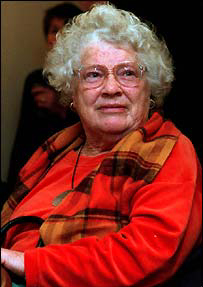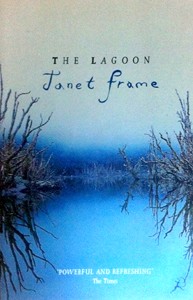
photo © Carl Jantzen 2006
by Jennifer Harvey
In 1951, following a diagnosis of schizophrenia, Janet Frame was admitted to a mental hospital. In an era before the development of psychotherapeutic medication there were few therapies available for patients suffering from severe mental illness. One ‘cure’ did exist, however: the transorbital lobotomy. The procedure is defined by thefreedictionary.com as: ‘A surgical interruption of nerve tracts to and from the frontal lobe of the brain; often results in marked cognitive and personality changes.’ To perform a transorbital lobotomy, the surgeon would, at that time, insert a modified ice pick through a patient’s eye socket using a hammer. The pick is then moved from side-to-side to separate the frontal lobes from the thalamus, the part of the brain that controls sensory input.
The theory behind the procedure held that cutting the ‘emotional’ connections within the brain would control the symptoms of a wide-range of mental disorders, including schizophrenia. The post-operative reality, however, was very different. Many patients suffered a distinct mental impairment and a reduced capacity to think abstractly and creatively. After being admitted to hospital, Frame was scheduled to undergo such a procedure. Then her short story collection The Lagoon won the Hubert Church Award, and the operation was cancelled. She had been saved by her writing.
This is not an essay about madness or its effects on Frame’s life. Much has been written on that subject already and Frame was more than aware of her notoriety in this regard, commenting that ‘Until Jane Campion’s film, I was known as the mad writer. Now I’m the mad fat writer’. Rather, this is an essay about the way a writer sees the world, and the sensitivities a writer brings to experiences which may, at times, come close to madness. In particular, I want to look at the collection that saved Janet Frame’s life.
The world depicted in the stories of The Lagoon is a familiar place. It fascinates, delights, and terrifies, in ways the world always does. And yet, there is no denying it is also a little off-centre. It’s as if the familiar has been placed behind splintered glass, leaving the outlines recognisable, while the whole becomes disturbingly disjointed. It’s there in the way the landscape is described. In the title story, for example, the water clearly harbours secrets.
At low tide the water is sucked back into the harbour and there is no lagoon, only a stretch of dirty grey sand shaded with dark pools of sea water where you may find a baby octopus if you are lucky, or the spotted orange old house of a crab or the drowned wreckage of a child’s toy boat.
What’s so intriguing about this story is the way Frame uses her observations of the landscape to help build up the revelations and secrets which will unfold as the story progresses. It’s as if the landscape itself is prepared to reveal hidden truths to us if only we are capable of stopping to look. That child’s boat in the water is a portent of sorts but we only recognise it as such because it is pointed out to us. It is not some discarded trash, washed ashore without meaning. It holds the key to the entire story.
The narrator in ‘The Lagoon’ is, in some ways, like the reader. We, and she, are being shown things that we may have only been aware of on a subconscious level. We are slowly and deftly guided by a writer who sees the world from a different perspective. Frame’s insight and her ability to look at the world in an ‘abnormal’ way give us a way of seeing the world that goes beyond the immediate and the sensory. Through this ‘abnormal’ take on reality, Frame is able to give it form and meaning. Perhaps this is what the committee of the Hubert Church Award recognised when they read these stories back in 1951.
Writers have long puzzled over the source of their ‘inner voice’. The inspiration that often grips a writer is, in some ways, a process of letting go of your ‘own’ voice, in order to let in that of ‘another’: the characters in your stories. Charles Dickens was reputedly so attuned to the voices in his head, that at public readings he was able to delight audiences by producing animated characterisations for each of them. When asked about the process of channelling these voices and characters he explained: “some beneficent power shows it all to me, and tempts me to be interested, and I don’t invent it – really do not – but see it, and write it down.” As readers we experience something similar when we read – ‘hearing’ our own inner voice as we interpret and imagine the story on the page in front of us. But what is it like for a writer to experience the actual creation of such a voice? To transform that auditory hallucination into a character and voice which can be absorbed and understood by another person.
 In The Lagoon, Frame comes very close to providing us with a glimpse into what it may be like to experience such a magical process. ‘Dossy’ invites the reader into a little girl’s world – a world full of daydreams and innocent observations. As the girl plays with her older friend, Dossy, she imagines her friend’s home to be a place full of wonder and allure:
In The Lagoon, Frame comes very close to providing us with a glimpse into what it may be like to experience such a magical process. ‘Dossy’ invites the reader into a little girl’s world – a world full of daydreams and innocent observations. As the girl plays with her older friend, Dossy, she imagines her friend’s home to be a place full of wonder and allure:
The little girl thought that Dossy must live in a big house at the end of a long long street. With a garden. And a plum tree. And a piano in the front room. And a piano-stool to go round and round on.
The voice in this story, as with so many of the stories in this collection, is a child’s. It is also a quaint and slightly old-fashioned voice, all ‘gosh’ and ‘golly’, and it can easily fool the reader into believing the world depicted is just as sweet and innocent. But a dark undercurrent lurks nonetheless. In ‘Dossy’, the language and the voice set the reader up for the final twist in the tale. But it’s not so much that you ‘see’ the ending coming as much as you ‘feel’ it. For Dossy and her little friend are one and the same. Because this is revealed only at the end of the story, we experience Dossy’s imaginary world as she is experiencing it. We believe in it in the same way she believes in it. The revelation, when it comes, is shocking, not because it is some sort of trick played on the reader and revealed with a flourish and a ta-da! Rather, it is shocking because Frame has so thoroughly succeeded in allowing us, the reader, to step inside Dossy’s mind, that the sudden understanding that there is nothing there beyond the dreams of a lonely little girl, hits us hard.
Every time I read this story, I am struck by the poignancy of that idea; by the sense that those things Frame has encouraged me to imagine, the world she has allowed me to enter and envisage, seem very real while I am reading her words. Even though I know I am inhabiting a world which exists only as a story on a page, the vividness of the girls’ play and conversation is so rich, and their world so real, that to accept it as nothing more than an a hallucination jars the reader.
In her autobiography, An Angel at My Table, Frame wrote: ‘My writing saved me.’ I think we too can be saved by writing such as this. What The Lagoon shows us is that there are writers who are capable of disrupting our sense of ‘self’ so completely that they deliver us straight into the mind and experience of another. It’s a remarkable achievement and something that can only serve to enrich us as individuals.
I think Janet Frame was aware of this. She understood the power of imagination, the power of the written word. She knew that the worlds we create in our minds are sanctuaries of sorts, places where we can exist outside of ourselves, places we all need to inhabit, from time to time.
~
 Jennifer Harvey is a Scottish writer now based in Amsterdam. Her work has appeared in Carve Magazine, Litro Online, The Guardian and various anthologies. She has been shortlisted twice for the Bridport Prize and her radio dramas have won prizes and commendations from the BBC World Service.
Jennifer Harvey is a Scottish writer now based in Amsterdam. Her work has appeared in Carve Magazine, Litro Online, The Guardian and various anthologies. She has been shortlisted twice for the Bridport Prize and her radio dramas have won prizes and commendations from the BBC World Service.

